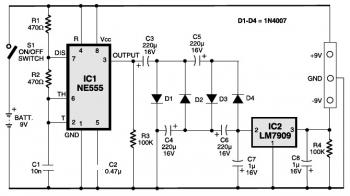Here the schematic design of 9V dual polarity power supply from 9V battery. Dual-voltage power supply is necessary particularly for running the op-amps and some of the instrumentation amplifiers. Some low-power audio pre-amplifiers also use dual-voltage power source.
This circuit delivers both +9V as well as -9V DC output from a single 9V battery. It contains timer IC NE555 (IC1), negative-voltage regulator IC 7909 (IC2) along with several discrete parts.
Timer IC NE555 is set up as being a free-running oscillator. It generates approximately 100kHz frequency. An audio system would not pick up this frequency since it is above the audible assortment. Therefore a Villard cascade voltage multiplier is applied as the voltage booster. The boosted voltage is produced ripple-free and regulated to -9V by negative-voltage regulator LM7909.
The frequency of the squarewave generator is determined by the values of C1, R1 and R2. The frequency of the signal may slightly change with the temperature variation but the modification in frequency will not have an impact on the output voltage of the circuit.
Capacitors C3, C4, C5 and C6 and diodes D1, D2, D3 and D4 form the Villard cascade voltage multiplier. The output voltage from the Villard cascade voltage multiplier is fed to linear negative-voltage regulator IC2 to remove ripples and get precise -9V DC. Capacitors C7 and C8 present extra noise-filtering. The output from voltage regulator IC2 is -9V.
Build the circuit on a general-purpose PCB and enclose inside a appropriate case. Fix the 9V battery inside the case. At the front panel, connect three terminals for outputs. Take a note that this power supply tend to be utilized only for low-power applications/devices.
9V Dual Polarity Power Supply from 9V Battery, Circuit Source: Electronics For You Mag

Comments